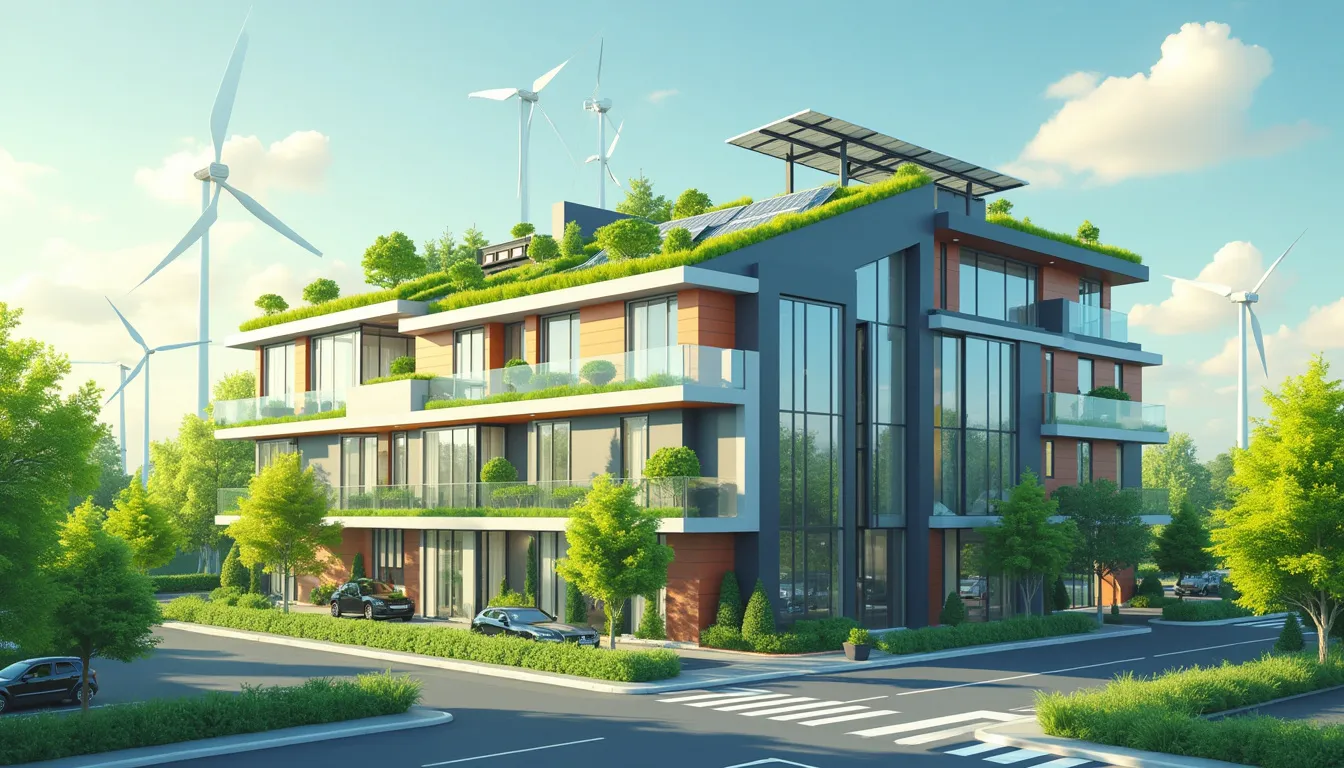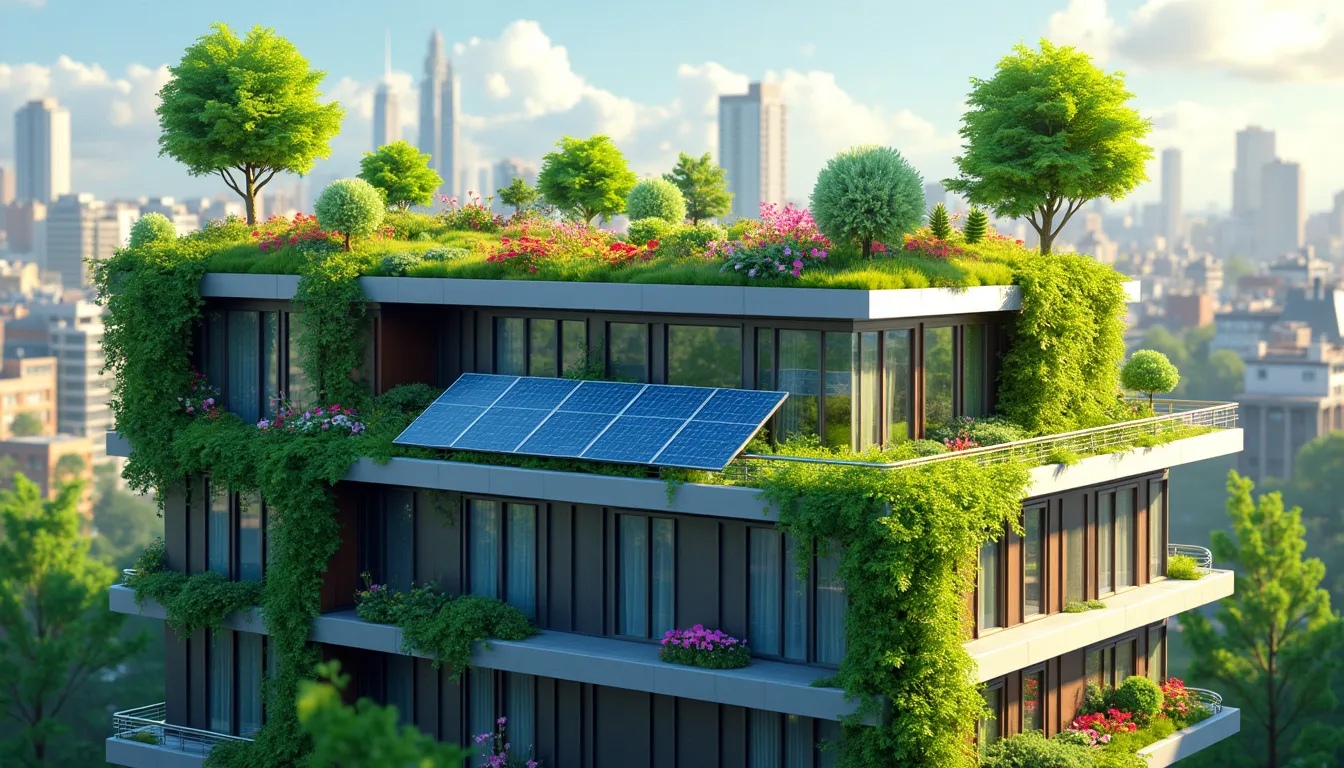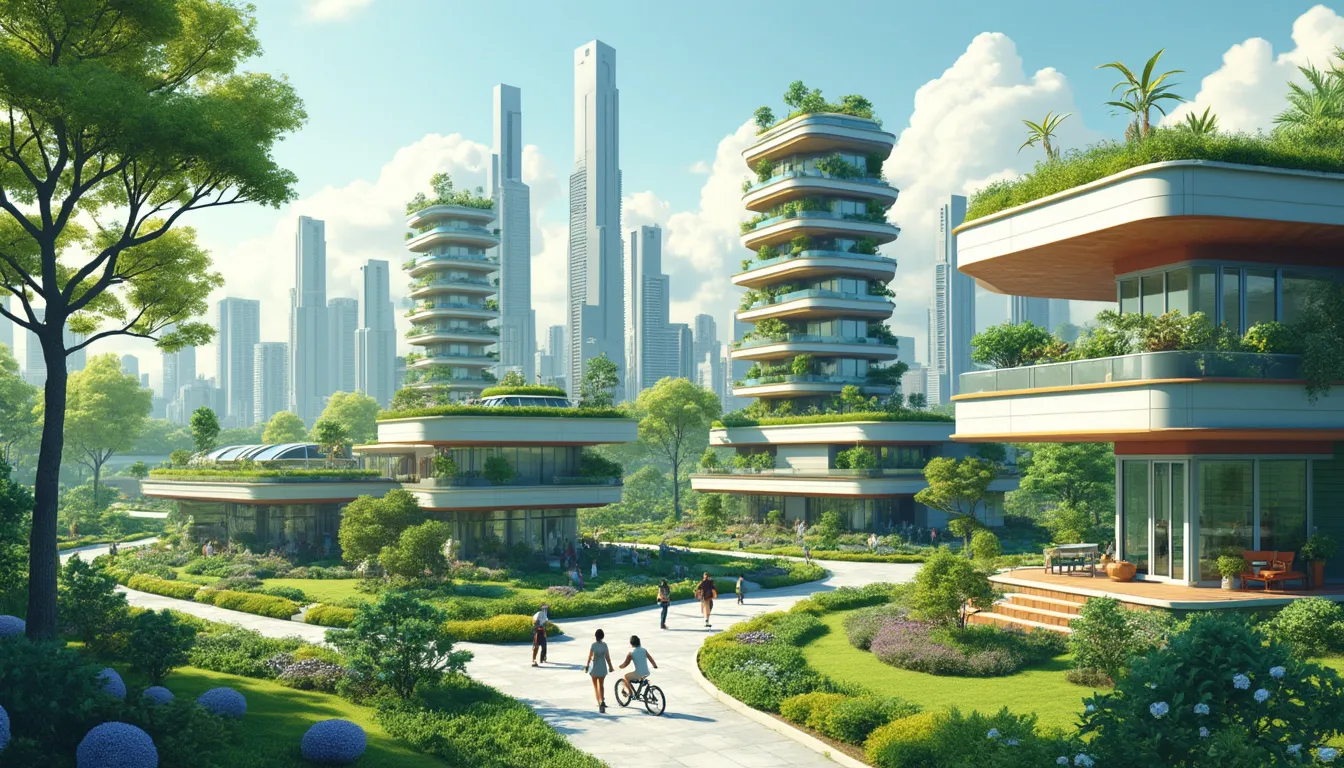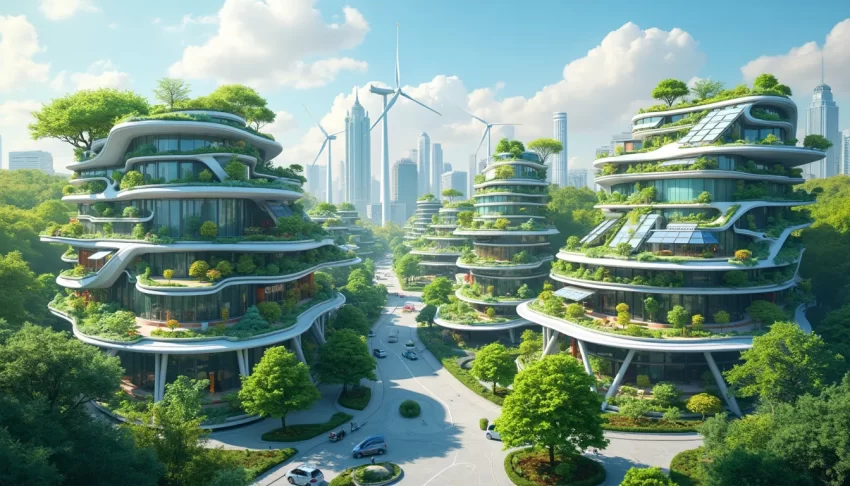Imagine a world where our buildings are not only beautifully designed but also harmonious with the environment, minimizing their carbon footprint while maximizing comfort and efficiency. Welcome to the future of sustainable architecture—a field where innovation and environmental stewardship converge to pave the way for a more resilient and eco-friendly built environment. Sustainable architecture, at its core, is about creating structures that have a minimal impact on the natural world, striving for energy efficiency, and using resources wisely.
As our planet faces the mounting challenges of climate change, resource depletion, and environmental degradation, the importance of sustainability in modern building design has never been more critical. It’s not just about constructing green buildings; it’s about rethinking how we design, build, and operate every structure. This paradigm shift is gaining momentum, driven by the urgent need to reduce greenhouse gas emissions, conserve natural resources, and create healthier living spaces for us all.
Currently, we are witnessing a growing interest in sustainable architecture, fueled by advancements in technology, increasing environmental awareness, and supportive policy frameworks. From energy-efficient skyscrapers in urban jungles to eco-friendly residential communities, the trends are clear: sustainability is not just a buzzword—it’s a blueprint for the future. This article will take you through the key principles of sustainable architecture, explore cutting-edge technologies, and offer a glimpse into what the future holds for this transformative field. Whether you’re a homeowner aspiring to make greener choices or a business leader looking to invest in sustainable building practices, there’s something here for everyone.
So, let’s embark on this journey to discover how sustainable architecture is poised to reshape our world, providing innovative solutions to some of our most pressing environmental challenges. Together, we can build a future where our architectural footprint is as light as our hopes are high.
Introduction to Sustainable Architecture
Definition of Sustainable Architecture
Sustainable architecture, sometimes referred to as green architecture or environmental architecture, is a design approach that prioritizes minimizing the negative environmental impact of buildings. Through thoughtful and innovative planning, construction, and maintenance, sustainable architecture seeks to create structures that are environmentally responsible and resource-efficient throughout their life cycle—from siting to design, construction, operation, maintenance, renovation, and deconstruction.
Importance of Sustainability in Modern Building Design
The necessity of sustainability in modern building design cannot be overstated. Buildings are significant consumers of energy and resources, contributing to a considerable portion of global greenhouse gas emissions. According to the World Green Building Council, buildings account for nearly 39% of CO2 emissions worldwide. Sustainable architecture addresses this pressing issue by integrating environmentally resilient strategies, which not only reduce carbon footprints but also create healthier living and working spaces.
Beyond environmental benefits, sustainable buildings offer economic and social advantages. Energy-efficient designs reduce operational costs for heating, cooling, and lighting, while eco-friendly materials extend the lifespan of buildings and reduce maintenance expenses. Moreover, sustainable architecture enhances occupants’ well-being with improved air quality, natural lighting, and ergonomic spaces, fostering productivity and better health outcomes.
Current Trends and Growing Interest in Sustainable Architecture
Interest in sustainable architecture is rapidly growing, driven by both a deeper environmental consciousness and a greater recognition of the long-term benefits. Key trends in this field include:
- Net-Zero Energy Buildings: Net-zero energy buildings generate as much energy as they consume, often through a combination of energy-efficient design and on-site renewable energy sources like solar panels. These structures are poised to become the standard in sustainable construction as technology advances and costs drop.
- Biophilic Design: Emphasizing the human connection to nature, biophilic design incorporates natural elements such as green walls, water features, and ample natural light. This approach not only boosts environmental sustainability but also improves mental and physical health by mimicking natural ecosystems.
- Adaptive Reuse: Instead of demolishing old buildings, adaptive reuse repurposes existing structures for new uses. This practice preserves cultural heritage, reduces construction waste, and minimizes the carbon footprint associated with new builds.
- Smart Building Technologies: Integration of IoT (Internet of Things) and smart technologies is revolutionizing building management. Automated lighting, HVAC systems, and real-time energy monitoring optimize resource use, enhancing efficiency and sustainability.
Indeed, the momentum behind sustainable architecture is growing, influenced by a convergence of policy, market demand, and innovative technology. The architecture sector is seeing a paradigm shift towards more resilient, efficient, and ecologically responsive building practices—demonstrating that sustainability is not just a trend but a critical component of future-proof design.
The promise of sustainable architecture is immense. As we continue to innovate and adapt, this approach heralds a new era where our built environment harmonizes with the natural world, leading to a healthier, more sustainable future for all.

Key Principles of Sustainable Architecture
Energy Efficiency and Renewable Energy
In the realm of sustainable architecture, energy efficiency stands as a cornerstone principle. Buildings account for approximately 40% of global energy consumption and related CO2 emissions, making it imperative to reduce their energy footprint. Energy-efficient design revolves around optimizing a building’s orientation, insulation, and glazing to minimize the need for artificial heating and cooling. For instance, strategically positioning windows to maximize natural light can significantly cut lighting costs while reducing the heat load during summer and retaining warmth in winter.
Renewable energy integration doesn’t just complement energy efficiency—it powers the future of sustainable architecture. Utilizing solar panels, wind turbines, and geothermal systems, buildings can generate their own clean energy, drastically reducing reliance on fossil fuels. Take the Bullitt Center in Seattle, often dubbed the greenest commercial building, which achieves net-zero energy by harnessing power through its extensive photovoltaic array.
Use of Eco-Friendly Building Materials
The choice of materials plays a critical role in sustainable architecture. Eco-friendly materials, sourced responsibly, reduce environmental impacts and enhance building performance. Bamboo, for example, has surged in popularity due to its rapid renewability and strength. It’s versatile enough for floors, walls, and structural components.
Innovative materials like cross-laminated timber (CLT) also demonstrate the benefits of eco-friendly choices. CLT is not only sustainable but also boasts high strength and durability. Consider the Stadthaus in London, an impressive example of a high-rise constructed primarily from CLT, significantly cutting carbon emissions traditionally associated with concrete and steel.
Upcycled and recycled materials further promote sustainability. Reclaiming materials from old structures and repurposing them into new builds can conserve resources and reduce waste. The Brighton Waste House, an incredible project in the UK, showcases how discarded materials can create an energy-efficient and robust building.
Water Conservation Techniques
Sustainable architecture also prioritizes water conservation, aiming to minimize water use and maximize efficiency. Rainwater harvesting systems capture and store rainwater for non-potable uses like landscaping irrigation and toilet flushing, reducing the demand on municipal water supplies. The Rachofsky House in Dallas is one example where an integrated rainwater collection system supports a sustainable garden and irrigation system.
Low-flow fixtures and appliances, such as faucets, showerheads, and toilets, are easy yet impactful water-saving solutions. These technologies can cut household water consumption by up to 60%, according to the Environmental Protection Agency (EPA).
Greywater recycling systems, which capture wastewater from sinks and showers for reuse in irrigation and flushing, present another innovative solution. The Edge in Amsterdam, widely regarded as one of the most sustainable office buildings, incorporates such systems, reducing water waste significantly.
Indoor Environmental Quality Enhancement
Lastly, enhancing indoor environmental quality (IEQ) is central to sustainable architecture. IEQ focuses on the health and comfort of building occupants, integrating elements like air quality, natural lighting, and acoustics. This is not only better for the environment but also crucial for human well-being.
Good air quality, achieved through proper ventilation and the use of non-toxic materials, reduces exposure to pollutants. Adopting materials with low volatile organic compounds (VOCs) can prevent harmful emissions. The PNC Tower in Pittsburgh, for example, achieves excellent air quality through an advanced natural ventilation system, reducing the need for artificial conditioning.
Natural lighting, apart from reducing energy use, positively impacts occupant mood and productivity. The New York Times Building maximizes natural light through its transparent facade and automated shading system, enhancing both energy efficiency and employee satisfaction.
Acoustic comfort is another facet of IEQ, often addressed in sustainable architecture. Using sound-absorbing materials and designing for optimal acoustics can enhance concentration and reduce stress in office environments. The Pixie Institute in the Netherlands employs these principles to create a serene yet stimulating environment for employees.
By adhering to these key principles of energy efficiency, eco-friendly materials, water conservation, and indoor environmental quality enhancement, sustainable architecture not only mitigates its environmental impact but also fosters healthier and more enjoyable living and working spaces.

Cutting-Edge Technologies and Innovations in Sustainable Architecture
Green Roofing Systems and Vertical Gardens
Green roofing systems and vertical gardens represent the burgeoning edge of sustainable architecture. These innovations have dual benefits: they enhance aesthetics and contribute significantly to environmental sustainability.
Green roofs, which involve the installation of a layer of vegetation over a building, help to reduce energy consumption by insulating the building against extreme temperatures. This contributes to lower energy costs and a smaller carbon footprint. For example, the Chicago City Hall’s green roof, which spans over 20,000 square feet, has proven to lower surrounding air temperatures by up to 15 degrees Fahrenheit during summer months. Not only does this reduce the heat island effect, but it also decreases the demand for air conditioning.
Vertical gardens, or living walls, are another revolutionary technology. By growing plants vertically along the exterior or interior walls of buildings, they maximize limited urban space while improving air quality. These gardens provide natural insulation, reduce noise pollution, and enhance the wellbeing of inhabitants by bringing nature into urban environments. The CaixaForum Museum in Madrid, with its expansive vertical garden, is a stellar example of how this innovation can transform concrete jungles into greener, more pleasant spaces to live and work.
Advanced Insulation Materials and Techniques
Traditional insulation materials are being replaced by advanced alternatives that offer superior thermal performance and are more environmentally friendly. Aerogel, often dubbed as frozen smoke, is one such material. Despite being incredibly lightweight, aerogel has one of the lowest thermal conductivity ratings of any known material, making it an exceptional insulator.
Furthermore, phase-change materials (PCMs) are catching the attention of architects and builders. These advanced materials absorb and release thermal energy during phase transitions, effectively regulating indoor temperatures without the need for complex HVAC systems. This technology has been successfully implemented in the development of energy-efficient buildings in various climates, from the sweltering deserts of Dubai to the chilly environments of Scandinavia.
New techniques such as vacuum insulation panels (VIPs) are also revolutionizing the industry. VIPs offer ten times the insulation value of traditional materials, despite their thin profiles. This means buildings can achieve the same thermal performance with much thinner walls, allowing for more interior space and improved design flexibility.
Solar Energy Integration and Smart Grids
As the cost of solar panels continues to decrease, their integration into architectural designs is becoming more prevalent. Solar energy now forms a cornerstone of sustainable architecture, providing clean, renewable power that reduces reliance on fossil fuels and lowers greenhouse gas emissions.
Building-integrated photovoltaics (BIPV) integrate solar panels seamlessly into building materials such as roofs, facades, and windows. This design approach not only generates electricity but also enhances the aesthetic appeal of buildings. For instance, Freiburg’s Solarsiedlung (Solar Settlement) in Germany features 50 solar-powered homes and commercial spaces, showcasing the potential of this technology in creating self-sustaining communities.
The implementation of smart grids further augments the potential of solar energy. These grids enable buildings to use electricity more efficiently by dynamically balancing supply and demand. Smart meters and connected devices allow homeowners and businesses to monitor and manage their energy usage in real time, optimizing consumption patterns and reducing waste. For example, the IIT Campus in Chicago uses a smart microgrid to manage its diverse energy needs, harnessing solar power during peak times and storing excess energy for future use.
Building Information Modeling (BIM) for Sustainable Design
The adoption of Building Information Modeling (BIM) is transforming the landscape of sustainable architecture. BIM is a digital representation of a building’s characteristics and functions, allowing architects, engineers, and builders to collaborate seamlessly from the design phase through to construction and maintenance.
BIM facilitates the incorporation of sustainable practices by providing detailed simulations of a building’s energy performance and environmental impact. This allows for the optimization of design choices and the identification of potential inefficiencies before construction begins. The application of BIM in the design of One Angel Square in Manchester, UK, resulted in a building that achieved a BREEAM Outstanding rating, the highest possible standard for sustainable architecture.
Moreover, BIM’s data-rich models support the use of prefabrication and modular construction techniques, which significantly reduce construction waste and improve the efficiency of building processes. By optimizing material use and minimizing the need for on-site adjustments, these methods contribute to the overall sustainability of building projects.
In summary, the incorporation of green roofing systems, advanced insulation materials, solar energy integration, and BIM represents the cutting-edge of sustainable architecture. These technologies and innovations not only enhance the environmental performance of buildings but also pave the way for smarter, more efficient, and aesthetically pleasing designs. As these advancements continue to evolve, they will play a crucial role in shaping a more sustainable future for our built environments.

The Future of Sustainable Architecture
Predictions and Trends for the Next Decade
As we look towards the future of sustainable architecture, several key trends and predictions emerge that are set to redefine the way we design and construct buildings. One significant trend is the continued advancement of smart building technology. According to a report by Grand View Research, the smart building market is expected to reach USD 265.37 billion by 2025. This growth is driven by the integration of IoT (Internet of Things) devices and AI (Artificial Intelligence) in building management systems, which optimize energy use, enhance security, and improve occupant comfort.
Another trend is the increasing use of prefabrication and modular construction methods. These techniques not only reduce construction waste but also shorten building timelines, making them more cost-effective and environmentally friendly. A McKinsey report highlights that modular construction could cut costs by up to 20%, while also reducing the environmental impact of construction projects.
Moreover, the adoption of sustainable building certifications such as LEED (Leadership in Energy and Environmental Design) and BREEAM (Building Research Establishment Environmental Assessment Method) is expected to become more widespread. These certifications help standardize sustainable practices and encourage developers to adopt green building strategies.
Role of Policy and Regulations in Promoting Sustainable Practices
The future of sustainable architecture will also be significantly influenced by policies and regulations. Governments around the world are recognizing the urgent need to address climate change and are implementing policies to reduce carbon emissions from buildings. For instance, the European Union’s Energy Performance of Buildings Directive mandates that all new buildings must be nearly zero-energy by 2021.
In the United States, various states have adopted stringent building energy codes that require higher energy efficiency standards. California’s Title 24 Building Energy Efficiency Standards, for instance, is one of the most ambitious codes aimed at reducing energy consumption in buildings.
In addition to regulations, incentives play a crucial role in promoting sustainable architecture. Tax credits, grants, and rebates for green building projects encourage developers to adopt sustainable practices. For instance, the Federal Energy Management Program in the U.S. provides funding for energy-efficient projects in federal buildings.
Examples of Pioneering Sustainable Buildings and Their Impact
There are numerous examples of pioneering sustainable buildings that showcase the potential of green architecture. The Edge in Amsterdam, often hailed as the greenest building in the world, serves as a beacon of sustainable innovation. With its intelligent design, it harnesses solar energy, collects rainwater, and uses state-of-the-art materials to minimize energy consumption. This building not only reduces its environmental footprint but also enhances the well-being and productivity of its occupants.
Similarly, the Bosco Verticale in Milan makes a compelling case for vertical forests. These residential towers feature over 900 trees and 20,000 plants, addressing the urban heat island effect, improving air quality, and creating a habitat for birds and insects. This innovative approach to sustainable architecture proves that urban living and biodiversity can coexist harmoniously.
The Bullitt Center in Seattle is another exemplary model of sustainable design. Deemed the world’s greenest commercial building, it generates its energy through a rooftop solar array, treats its wastewater on-site, and utilizes sustainable materials in its construction. These pioneering examples demonstrate that sustainable buildings can lead the way in reducing our environmental impact while offering practical benefits.
How Sustainable Architecture Can Contribute to Combating Climate Change
Sustainable architecture plays a pivotal role in combating climate change by reducing greenhouse gas emissions and enhancing resilience to climate impacts. Buildings account for roughly 40% of global energy consumption and contribute significantly to carbon dioxide emissions. By adopting energy-efficient designs and renewable energy systems, sustainable architecture can drastically cut down on these emissions.
For example, passive design strategies, such as orienting buildings to maximize natural light and ventilation, can significantly reduce the need for artificial lighting and HVAC systems. Incorporating renewable energy sources, such as solar panels and wind turbines, further reduces reliance on fossil fuels.
Water conservation techniques, like rainwater harvesting and greywater recycling, also play a crucial role in sustainable architecture. These practices not only reduce water consumption but also mitigate the impact on local water resources, which is increasingly important as climate change affects water availability.
Moreover, sustainable buildings enhance resilience against climate-related events like hurricanes, floods, and heatwaves. Designing structures with durable materials, efficient drainage systems, and adaptable layouts ensures that buildings can withstand and recover from extreme weather events.
In conclusion, the future of sustainable architecture is bright and promising. Predictions for the next decade point to a surge in smart building technologies, modular construction, and the adoption of sustainable building standards. Policymaking and regulations will play a crucial role in driving the green building movement, while incentives will encourage more developers to invest in sustainable practices. Pioneering projects worldwide, such as The Edge, Bosco Verticale, and the Bullitt Center, offer inspiring examples of what can be achieved through innovative design. Ultimately, sustainable architecture not only helps mitigate climate change but also improves the quality of life for all.
As we look towards the future of sustainable architecture, it’s clear that this field holds enormous promise for addressing some of our most pressing environmental challenges. Over the next decade, we can expect to see a continued emphasis on energy efficiency, the adoption of advanced technologies, and more robust policies to encourage sustainable building practices. The rise of green roofing systems and vertical gardens not only beautifies urban landscapes but also significantly reduces buildings’ carbon footprints and promotes biodiversity. Innovations in insulation materials and integration of solar energy offer practical solutions that underscore sustainability’s feasibility and profitability.
The role of policy and regulation cannot be overstated in this context. Governments worldwide are beginning to recognize the importance of sustainable architecture and are implementing measures to encourage and, in some cases, mandate these practices. These policies will likely become more stringent and widespread, pushing the construction industry towards greener standards and further reducing environmental impacts.
Pioneering examples of sustainable buildings, such as the Bullitt Center in Seattle or The Edge in Amsterdam, serve as inspiring benchmarks for what can be achieved. These buildings showcase not just the environmental benefits, but also the economic and social advantages of sustainable architecture. By decreasing operational costs, improving occupant health, and fostering corporate social responsibility, these structures demonstrate a holistic approach to sustainability.
Crucially, sustainable architecture isn’t just for the large-scale projects or high-budget developments; it’s increasingly accessible to everyday homeowners and small business owners. Simple actions like choosing energy-efficient appliances, installing solar panels, or using reclaimed materials can make a significant difference. It’s about making conscious decisions that align with the broader goal of sustainability and environmental stewardship.
Incorporating sustainable practices into your daily life or business doesn’t have to be overwhelming. Start small— consider installing a rainwater harvesting system, switch to LED lighting, or support companies that prioritize eco-friendly materials and methods. Remember, every step matters and collectively, we can make a substantial impact.
The shift towards sustainable architecture is not just a trend; it’s a necessary evolution for our planet’s health and our future well-being. By embracing innovative solutions and committing to sustainable practices, we can build a world that is not only resilient and adaptable but also vibrant and thriving for generations to come.
Support Us: Check out our recommended products on Amazon.

